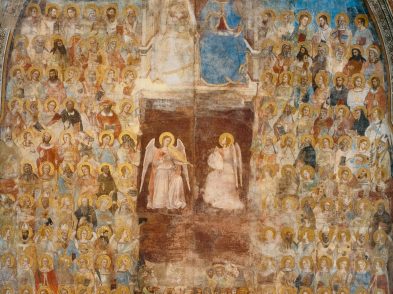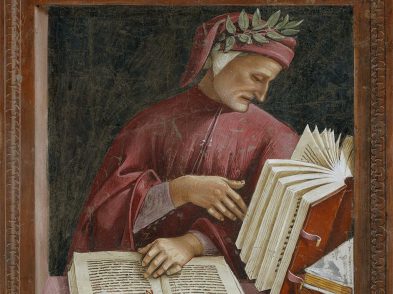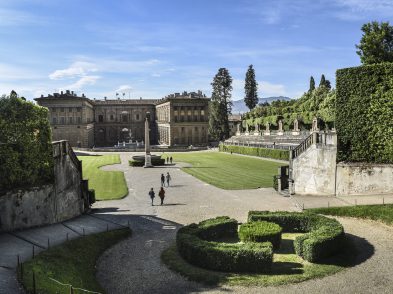A lot has changed since the court of Cosimo I de’ Medici swept into town in 1537 and began systematically defining the Medici legacy as the vital center of the Florentine Renaissance. The hope had been that young Cosimo, plucked from the Tuscan countryside as the only chance for continued Medici rule, would be easily manipulated by those seeking power but lacking the only last name that counted. Instead, Florence got a dynamic, dedicated ruler, one who envisioned restoring international prestige to the city and creating a commanding Tuscan state. Possessed by a keen sense of history and its importance in the collective consciousness of the city, Cosimo forged a series of cultural policies aimed at solidifying his family’s importance-past, present and future.
At the helm of these cultural policies was the creation of a pictorial representation of Medici power. Cosimo I commissioned countless portraits, allegorical stories and, given the raging Counter Reformation, religious works fraught with symbolism. Cosimo did not invent political and cultural propaganda but he did take it to new-and often dizzying-heights. One of the cardinal figures in the interpretation of the times was artist Agnolo di Cosimo, known as Bronzino (1503-1572), currently being celebrated in an exhibition at Palazzo Strozzi.
Bronzino: Artist and Poet at the Court of the Medici is the first exhibition to be devoted entirely to the work of this Florentine master. Bronzino’s sophistication as a court painter for the Medici has long been recognized but had never been the single focus of an exhibition until today. Thanks to loans from some of the world’s leading museums, visitors have the chance to admire over 70 paintings by the artist himself, alongside works by Pontormo, Cellini, Tribolo, Baccio Bandinelli, Pierino da Vinci and Alessandro Allori. Twenty-nine of the Bronzino pieces hail from the Uffizi Gallery; others were loaned from museums around the world, including the Metropolitan Museum of Arts, the Louvre, the National Gallery in Washington, the Getty and the Kunsthistorishces in Vienna.
Created by powerhouse curatorial team Antonio Natali, director of the Uffizi Gallery, and Carlo Falciani, one of Italy’s foremost Bronzino experts, the exhibition meticulously presents the artist’s works in a way that is at once scholarly and accessible. As they follow the exhibition’s seven schematic sections, visitors contemplate Bronzino’s artistic trajectory from his youthful apprenticeship with Pontormo to his short stint at the Pesaro court and back to Florence to become the chief image maker to the Medici.
All of the usual suspects are present-warrior Cosimo; stately Eleonora; cherubic Giovanni; incorrigible Bia-but many visitors may be surprised to see that Bronzino’s artistic output goes well beyond demure courtly portraiture. His splendid Nano Morgante, a double-sided nude of an infamous Medici court dwarf depicted before and after the hunt, was created in response to a contemporary question on whether painting or sculpture was the ‘nobler’ art form. In fact, the recently restored Morgante takes center stage in its exhibition room much like a sculpture would. While the exhibition highlights Bronzino’s aristocratic naturalism in painting, it also introduces us to his numerous poems, which range from courtly inspirations on Medici celebrations to racy, burlesque rhymes that poke fun at Cinquecento culture and society.
Even hardcore Bronzino fans will find something new: three pieces in the show have never been seen by contemporary viewers. Two were mentioned by Vasari and thought to be lost (St. Cosmas from Eleonora de Toledo’s chapel in Palazzo Vecchio and a breathtaking Crucified Christ painted for Bartolomeo Panciatichi); and one that was recently attributed to his later career (Christ Carrying the Cross).
Bronzino
Artist and Poet at the Court of the Medici.
Until January 23, 2011Palazzo Strozzi www.palazzostrozzi.org
For families
Fondazione Strozzi takes a special interest in children and families by offering workshops, story time, ‘stroller tours,’ special family Sundays, and an artist’s bag full of books and games for kids from 3 to 12 (call 055/2645155 to book your bag in advance). All activities can be offered in English by request (minimum participation may be necessary). Call Sigma CSC 055/2469600 or email prenotazioni@cscsigma.it to book. For those who can’t get to Palazzo Strozzi, the Kamishibai bike will bring the exhibit to them through stories and illustrations made just for kids.
For those wanting more
Related events are part of the ‘Bronzino fever’ around town. Grab the Bronzino Pass for reduced entrances to other sites, such as Santa Maria Novella, San Lorenzo and Museo Stibbert. Be sure to keep an eye on TF’s event listings for all things Bronzino.








